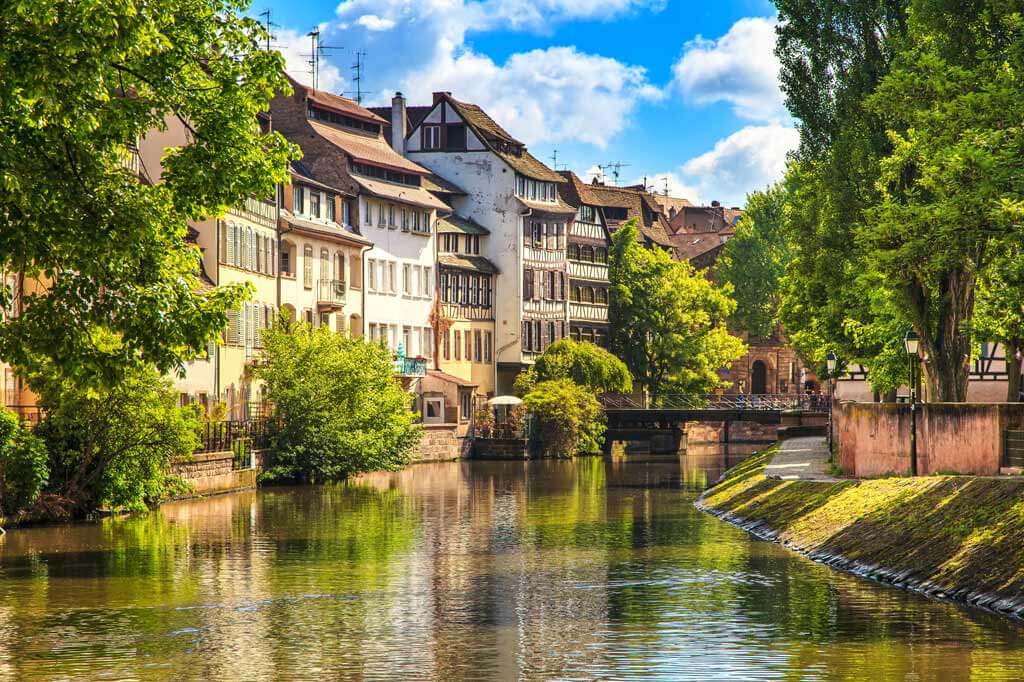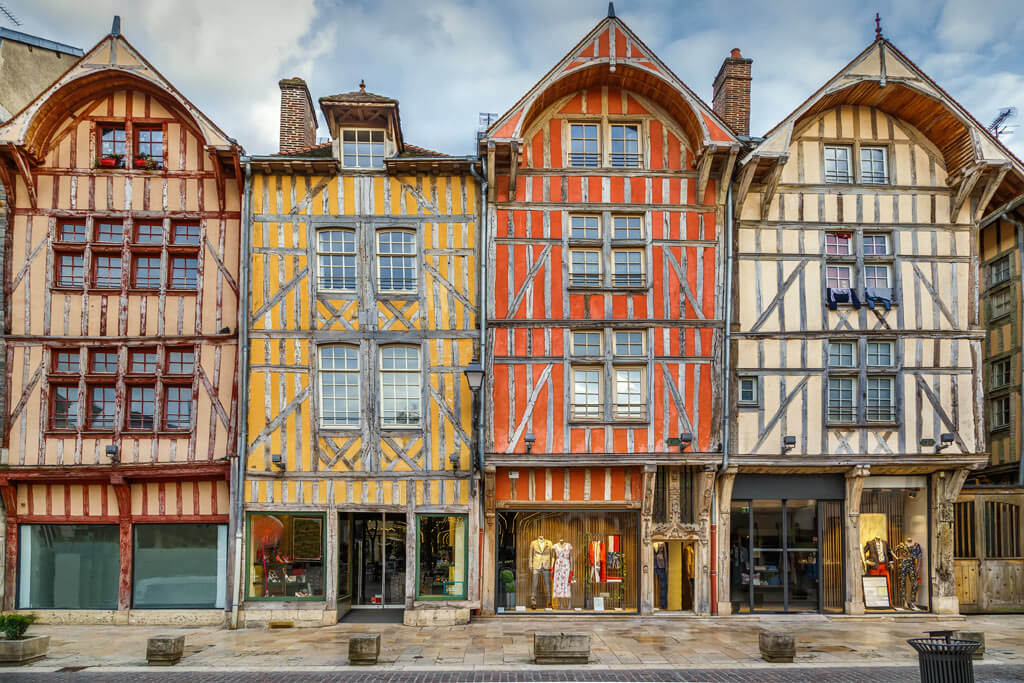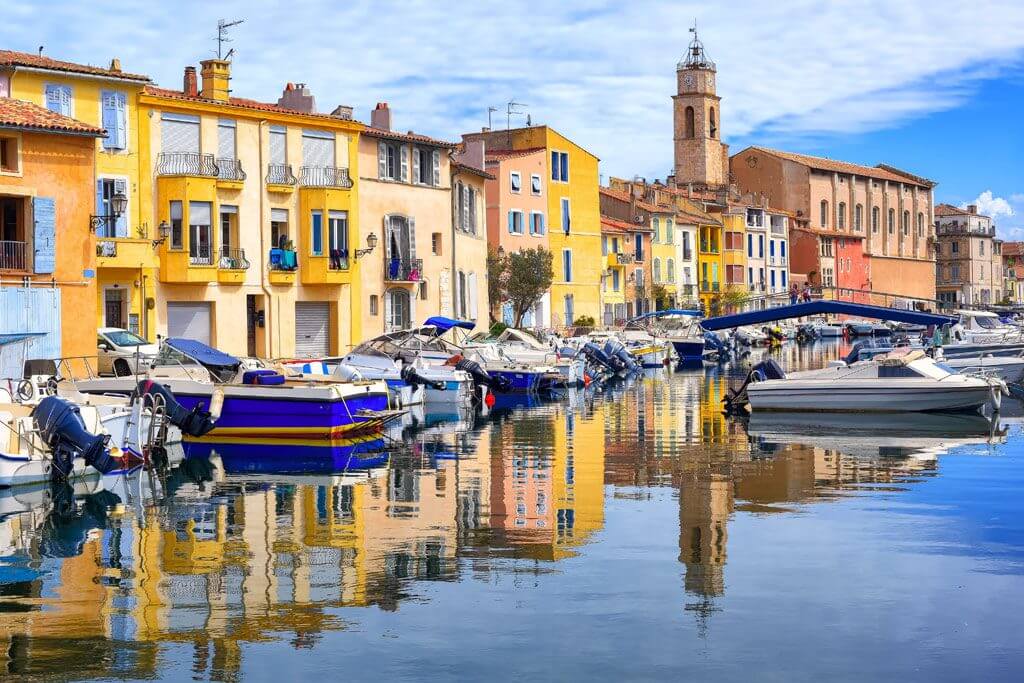Article written by Elisa - Travel Writer & Local in France
This article may contain compensated links. Please read disclaimer for more info.

Grand Est is a vast new region in Eastern France that includes the former historical regions of Champagne-Ardenne, Alsace, and Lorraine. World-famous wines, picturesque villages, natural wonders, and interesting history in a unique setting, the Grand Est region is all this and much more.
Its geographical location – bordering Belgium, Luxembourg, Germany, and Switzerland – makes the Grand Est region an interesting cultural melting pot that can be clearly seen in its architecture and tasted in its gastronomy.
Strasbourg is the region’s largest city and also its administrative capital. Cities like Reims, Metz, or Nancy are also great Grand Est destinations for weekend getaways.
If you have some extra time, take the road to explore quaint villages and taste some great wines and champagnes, without forgetting the region’s beautiful mountains, forests, and lakes.
The Grand Est region is divided into nine departments: Ardennes, Aube, Marne, Haute-Marne, Meurthe-et-Moselle, Meuse, Moselle, Bas-Rhin, Haut-Rhin, and Vosges.
Haven’t you visited the Grand Est region yet? Let us tell you the best things to do in Grand Est, France.
Related posts
Grand Est Travel
BY PLANE
The most important airport in the region is the International Airport Bâle-Mulhouse-Fribourg (MLH, BSL, EAP), also known as EuroAirport. Located on French soil, close to Mulhouse, this airport is a good option to explore southern Alsace. The EuroAirport has regular and seasonal international flights to Europe, Turkey, Israel, and Morocco.
Click here to book your flight tickets
BY TRAIN
The region of Grand Est is crossed by the classic lines Paris – Nancy – Strasbourg, and Paris – Troyes – Chaumont – Mulhouse. The two other main rail routes in the region are Basel – Mulhouse – Strasbourg (– Metz – Luxembourg) and Nancy – Metz – Luxembourg.
Thanks to the Rhine-Rhône high-speed line, the TGVs Marseille – Lyon – Frankfurt-am-Main travel through Alsace (via Mulhouse and Strasbourg).
From Paris, count on it taking 2 hrs to Strasbourg, and 1 hr 25 min to Metz, and only 45 min to Reims by TGV train.
Explore the Grand Est by Car
The region Grand Est is a great place for memorable road trips in France. With a car, some good tunes, and the best company, you are set for one of the best adventures in your life. Visit the main Grand Est tourist attractions and then go off the beaten path to get the most out of this wonderful region.
Recommended road trips in Grand Est:
If you don’t have your own car, we recommend booking in advance through platforms like DiscoverCars. This site takes all of the major rental companies, such as Hertz, Avis, etc., and compares prices for you. Check out our best tips for renting a car in France.
Top Things to Do in Grand Est Region, France
Let’s have a look at the best things to do in Grand Est, France. The list of Grand Est tourist attractions includes sightseeing, picturesque towns, cultural cities, natural wonders, and (of course) some of the best French wines.
1. Champagne Tasting in Epernay (Champagne)

The wonderful region of Champagne, with its rolling hills and vineyards everywhere, is one of the main Grand Est destinations. This area is especially beautiful after the harvest, with the fall colors.
Visit Epernay, the center of champagne production, and stroll through Avenue Champagne with its beautiful private mansions along it. Avenue de Champagne is considered the world’s most expensive avenue, thanks to the millions of champagne bottles stored below the grounds.
Explore Moêt & Chandon cellars and learn the history of one of the world’s most exclusive champagnes. Then, visit the small champagne producers (and taste their bottles) in the nearby villages.
Extend your trip to Hautvillers to visit the little Abbey of Saint-Pierre d’Hautvillers, where Dom Pérignon is buried. Dom Pérignon was a benedictine monk in this abbey who, according to the legend, invented the champagne wine.
Want more? Take this Champagne road trip that covers the best of the Champagne region.
2. Explore the Grande Ile in Strasbourg (Alsace)

People visiting the Grand Est region, France, cannot miss Strasbourg, the capital. Strasbourg is one of the main Grand Est destinations, a great city for sightseeing and tasting regional food and wines.
The Grande Île is Strasbourg’s beating heart, a large island that lies at the city’s historic center. On this island, you can find some of the best places to visit in Strasbourg, like Place Kléber, the quarter of Petite France – characterized by its canal system and historical buildings – or the Gothic cathedral.
Listed as a UNESCO heritage site since 1988, the Grande Ile is a charming area of Strasbourg to explore, especially for first-timers in Strasbourg. It has beautiful half-timbered houses and Renaissance houses plus many good restaurants and souvenir shops.
During the winter holidays, Strasbourg becomes France’s Christmas capital. Don’t miss the Strasbourg Christmas Market, the oldest and most famous Christmas market in France! – Click here for where to stay in Strasbourg
3. Get Cultured in Metz (Lorraine)

Metz, in the historical region of Lorraine, is one of the Grand Est cities ideal for a cultural weekend getaway. Crossed by the Moselle and Seille Rivers, Metz is home to extensive green space, a large pedestrian old town, and a university.
In Metz’s large pedestrian Old Town, the German door is the most imposing remaining part of the medieval ramparts whilst the Gothic Cathedral of Saint Étienne outstands for its massive amount of stained-glass windows.
Architecture lovers will like to stroll the Imperial Quarter, full of elegant streets and villas built in neo-Renaissance, neo-Romanesque, and art deco styles. This quarter was German Kaiser Wilhelm II’s idea to promote Metz after it became part of the Second Reich in 1871.
Finally, don’t miss the new Centre Pompidou-Metz Museum, hosting an interesting collection of Contemporary Art – Click here to book your hotel in Metz
4. Back to Nature in the Vosges Mountains (Alsace)

Set in the heart of the region, the Vosges Mountains are the perfect destination in Grand Est, France, for nature lovers.
In addition to the beautiful forests, pristine lakes, and superb views, the Vosges is also a center of adventure sports like nordic skiing, paragliding, and extreme canoeing.
People looking for a more relaxing stay can recharge their batteries in one of the spas of Ribeauvillé or Plombières-les-Bains whilst enjoying the traditional gastronomy.
5. Drive the Alsace Wine Route (Alsace)

If you are interested in wine travel, you will love the Alsace Wine Route, from Colmar to Strasbourg or vice-versa. The Alsace Wine Route is the most famous French wine route and makes one of the best French road trips.
Learn about Alsace’s wines, visit the picturesque Alsace villages with their cobbled streets and beautiful half-timbered houses, and marvel at the imposing medieval castles and their fascinating history!
6. A Royal Stroll at Stanislas Square in Nancy (Lorraine)

Stanislas Square, in Nancy, is one of the most beautiful squares in Europe, if not the most beautiful one!
Place Stanislas was commissioned in the 18th century by the Duke of Lorraine Stanislas Leszczyński. At that time, Nancy was divided into two areas, separated by ramparts: the medieval Old Town – with its ducal palace – and the Renaissance New Town – characterized by its wide straight roads.
Duke Stanislas wanted to unite these two neighborhoods to create a new, more beautiful Nancy, more in accordance with its status as the capital of the Lorraine. With this square, the Duke also intended to honor his son-in-law, King Louis XV.
Duke Stanislas chose the esplanade dividing the two towns as the site for a Royal Square dedicated to King Louis XV and entrusted the works to his architect Emmanuel Héré. The architect had a double challenge: create a magnificent backdrop for Louis XV’s royal statue and unify Nancy by bringing together the two towns.
Stanislas Square was built in the classic and rococo style and consisted of 3 squares arranged according to a perfect symmetry axis. All the buildings surrounding the square were created by Emmanuel Héré, a homogeneous classic architecture that presents a Corinthian style. Since 1983, the square is listed as a UNESCO Heritage site, and it is one of the main Grand Est tourist attractions – Click here to book your hotel in Nancy
7. Battlefield of Verdun – Learn About the Great War (Lorraine)

The Battle of Verdun in 1916 was a frontal collision, the deadliest in history, between France and the German Empire. This battle of annihilation, through an unprecedented artillery duel, symbolizes and summarizes total war.
From the start of the war in 1914, Verdun, its citadel, and the belt of forts that protected it were considered key to the French defensive system. That’s why the German strategists decided to take it.
The Battle of Verdun was the longest battle in human history, 302 days of non-stop combats that ended with a French defensive victory and the failure of the German offensive. Since then, this town bisected by the Meuse River became for the whole nation the symbol of courage and selflessness, and the resistance of French fighters in Verdun is still reported worldwide.
The Verdun Battlefield constitutes a unique place of memory in France and in the world. It also presents a set of remarkable sites key to understanding what was the Great War in the Meuse. Every year – usually from mid-June to mid-July – Verdun hosts The biggest show in Europe, a scenic evocation of the battle of Verdun.
8. Explore the Medieval Fair Town of Troyes (Champagne)

Troyes, in the south of Champagne, was one of the most important fair towns in France during medieval times, a center for hosiery and cloth making. Just like Provins, in Ile-de-France, Troyes hosted two huge annual fairs that brought craftsmen and merchants from all over Europe.
In 1524 a terrible fire destroyed much of the town, and Troyes had to be fully rebuilt. Much of what you see today is from that period of total reconstruction; that’s why there’s a level of harmony that you can’t find anywhere else in France.
A stroll around the Old Town steeped in history and with beautiful half-timbered houses reveals the town’s commercial past to us. Don’t miss Troyes’ Gothic Cathedral, considered one of the most beautiful churches in all of Europe.
9. Visit Reims’ Cathedral – Symbol of Royal Power (Champagne)

Reims, the unofficial capital of the historical region of Champagne, is a beautiful city to visit, with an interesting history and medieval heritage.
Among all the historical buildings in Reims outstands its Gothic Cathedral. The cathedral was dedicated to the Virgin Mary and is famous for being the traditional location for the coronation (le Sacre) of the Kings of France.
Why Reims Cathedral? Clovis, the king of the Franks, was the first Christian king and he was baptized in Reims Cathedral by Bishop St. Remy around 498 A.D. This act converted the Cathedral into a sacred ground for royals, especially since French kings claimed their rule was ordained by God. Legend tells us that St. Remy received a vile of oil from a white dove. This holy oil crowned every king up until Charles X in 1825.
Notre Dame de Reims is one of the main Grand Est tourist attractions. In addition to its historical importance, the Gothic Cathedral is known for its stained glass window and carved portals. The building is adorned with 2,303 statues, including the famous Smiling Angel, a masterwork of the Champagne School in the 13th century.
10. All Bugatti at Cité de l’Automobile in Mulhouse (Alsace)

La Cité de l’Automobile, also known of Musée national de l’Automobile, is built around the Schlumpf collection of classic automobiles. Located in Mulhouse, southern Alsace, La Cité de l’Automobile is one of the best Grand Est attractions for kids and adults.
The Schlumpf brothers were two local businessmen with a passion for cars. Their collection, located in one of their former factories, is the largest displayed collection of automobiles and contains the largest and most comprehensive collection of Bugatti cars in the world.
The museum displays some of the very first cars but also racing cars or luxury cars. Attached to the museum, there is a small race track where it is possible to test the most iconic Bugatti cars. Amazing!
11. Learn About the Vauban Fortifications

The Marquis of Vauban was a French engineer ordered Maréchal de France by King Louis XIV. Expert in poliorcetic (the art of organizing attack or defense during the siege of a city, place, or stronghold), Vauban designed or improved more than 150 strongholds in France. He built the Iron Belt, the network of fortifications on the borders of France, between 1665 and 1707, which remained functional until the 19th century.
Among all the Vauban sites, there are three located in the Grand Est region: the fortified towns of Longwy (Lorraine) and Neuf-Brisach (Alsace) plus the Barrage Vauban in the Grand Ile of Strasbourg (Alsace). Each of these sites is unique because of its interdependence with its context, so we recommend visiting all three if you have the time.
We hope that you enjoyed this list of Grand Est tourist attractions and destinations. If you want to learn about other regions, head to this article on the Regions of France, where we have summarized each region’s highlights.
Click here to Explore the French Regions
Pin it now & read it later




